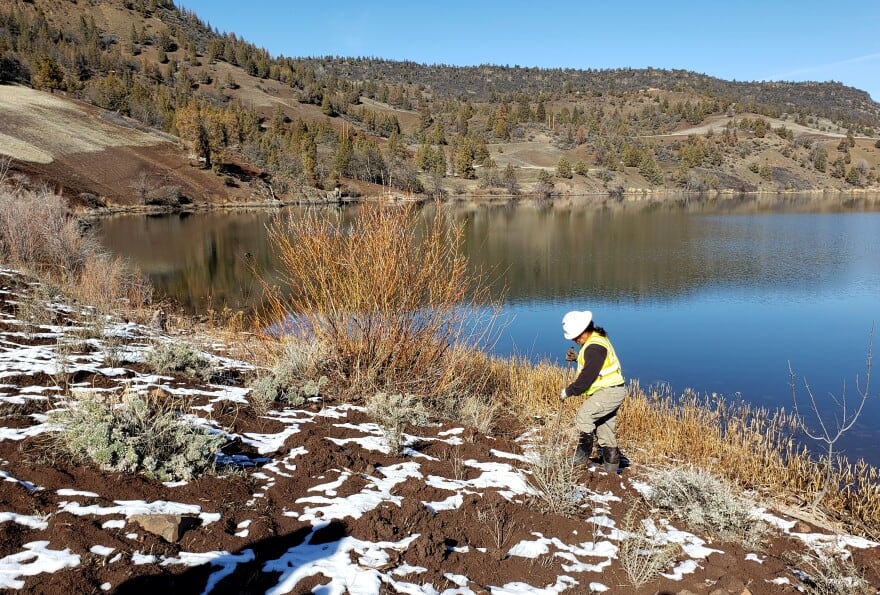

Photo: Yurok tribal member and Fish Technician 1 Frank Henry Jr. works alongside Iron Gate Reservoir in Feb. 2023. The reservoir will be drained when Iron Gate Dam is removed as part of the Klamath River restoration.
Restoration contractor Resource Environmental Solutions and area tribes will plant up to 19 billion native seeds as the Klamath Dams come out and reservoirs are drained.
On the north shore of Iron Gate reservoir, Frank Henry, Jr. jams a heavy metal pole into the ground and twists. Once a hole is excavated, he grabs a stick from a five-gallon bucket. Water drips from the small tangle of roots at one end. The stick is Klamath plum; it will eventually grow into a shrubby tree that forms dense thickets and produces mauve-colored fruits.
Henry pats native soil—moist, fluffy, and sticky with clay—around the plum plant, then moves on to the next one. “I’m digging maybe a 12–13-inch hole with the rock bar,” he says. “These little ones that are kind of cluttered together are the ones I’m putting in right now.”
It’s February; snow dusts the hills, and aside from the occasional rumble of trucks passing by the reservoir, it’s quiet. The air is cool but the winter sun is warming—not a bad day to work outside.


Henry is part of a crew contracted by Resource Environmental Solutions, or RES, to restore the banks of the Klamath River in the wake of dam removal. Late last year, PacifiCorp transferred ownership of four hydroelectric dams—three in Northern California; one in Southern Oregon—to the Klamath River Renewal Corporation, which is managing the dam removal. Drawdown of the reservoirs is scheduled to begin as early as next January.
Iron Gate is a sinuous, skinny reservoir tucked into the folds of the Siskiyou Mountains. Draining it will expose about 900 acres of wet mud. “It’s our job to make sure it’s revegetated. We want that to be revegetated with a healthy native plant ecosystem,” says Joshua Chenoweth, Senior Riparian Ecologist for the Yurok Tribe who is leading the replanting effort.
Phase one is to check the march of exotic invasive plants. For the last two years, Chenoweth’s crew has been […]
Full article: After the dams: Restoring the Klamath River will take billions of native seeds
Clean water is essential for life, yet millions of Americans unknowingly consume contaminants through their…
Human brains contain higher concentrations of microplastics than other organs, according to a new study, and the…
From the Office of the Governor: In anticipation of a multi-day, significant atmospheric river in Northern California,…
From Governor Newsom: Scientists, water managers, state leaders, and experts throughout the state are calling…
Photo: A harmful algal bloom in Milford Lake, Kansas, made the water appear bright green.…
An expanded plastic foam coffee cup is at a donut shop in Monterey Park, California.…